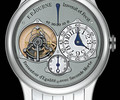Centigraph Souverain part 2
Centigraph Souverain by FP Journe
| Rating: 67 %1000 with 237 votes |
 3847
on December 22, 2008 at 04:41 p.m..
3847
on December 22, 2008 at 04:41 p.m..
 Yes a lot 0
Yes a lot 0  Not so much 0
Not so much 0
- Summary
- Centigraph Souverain
- Centigraph Souverain part 2
The external tachometer scale indicates speeds. The third dial, at 6 o’clock, graduated for 10 minutes, has a similar tachometer scale with speeds corresponding to 20-second markers. Thus, for example, a kilometre travelled in three minutes 40 seconds represents a speed of 16.4km/h (to within a decimal). Patented ergonomic chronograph The chronograph is started, stopped and zeroed by a rocker at 2 o’clock in the case band, instead of the usual buttons on either side of the crown.
This ergonomic design, perfectly fitted to the wristwatch, is patented. Patented chronograph mechanism A second patent was granted for the mechanism’s ingenious configuration, which effectively isolates the chronograph from the timekeeping function. This means the balance amplitude is unaffected when the chronograph is running.
The hands of the 100th of a second counter, the 20 seconds, and the 10 minutes hand are driven by 2 different wheel trains, themselves driven by the centre of the mainspring (system patented for the Sonnerie Souveraine). The 1-second counter and the 20-seconds counter are driven by two wheel trains on either side of a single intermediate wheel driven by the barrel arbor (patented for the Sonnerie Souveraine). Another separate train of wheels, also driven by the barrel arbor, drives the 10-minutes hand.
The 100th of a seconds hand, released by the watch's escapement, makes one revolution of the dial per second. A wheel mounted on the escape wheel (4th wheel of the going train) releases the arbor to which the hand is fitted. The seconds are driven by the going train from the barrel, and by the energy of the chronograph train, as transmitted by the barrel arbor.
One ingenious feature of the 100th of a second is that it may be stopped anywhere along its one-second journey around its dial, even between two 100th-second divisions, enabling a fractional reading. This is achieved by vertically disengaging the pinion of the 100th of a second hand from that of the escapement, which presses on the pivot shank and acts as a brake.
Return to zero The 20-seconds hand and the 10-minutes hand arbors are zeroed by hammer levers acting on snail cams. The 100th of a second hand is stopped at zero by a beak protruding from its pinion, which presses on a lever and thus blocks the chronograph train.
Maintaining power and power reserve The barrel features a maintaining power system in order to ensure that the driving force does not decrease during winding. The mainspring supplies at least 100 hours of power reserve without the chronograph, and 24 hours with the chronograph running. The Centigraphe, an atypical Godfather: Jean Todt For the creation of the Centigraphe, things happened slightly differently than for other creations. I met Jean Todt through the ICM Foundation, and during the course of our meetings we discussed the ideal chronograph for the world of car racing.
Research I carried out over 15 years ago for the creation of an exponential chronograph quickly showed me that a chronograph with 3 hands revolving at different speeds was a good starting base. I followed up with research on chronograph pushers, on questions of the balance of power in the movement, requirements, and energy loss, and I made use of a patent registered for the Sonnerie Souveraine. I patented 2 additional innovations concerning motricity.
I am proud that Jean Todt has agreed to be the Centigraphe’s Godfather. The Centigraphe Contributes to the Medical Research of the ICM In purchasing the Centigraphe, you are also supporting the medical research carried out by the ICM
The Institute of Brain and Spinal Cord in Paris - to help fight brain and spinal cord diseases such as Alzheimer’s, Parkinson’s, and Multiple Sclerosis... Along with Professor Gérard Saillant, Luc Besson, Jean Réno, Jean Todt, Michelle Yeoh and Michael Schumacher, amongst others, François-Paul Journe has committed to donating 30% of the profits from the sale of each Centigraphe to the ICM, with no time limit.





